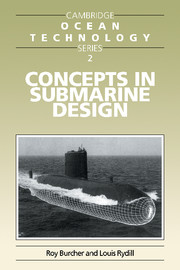Book contents
- Frontmatter
- Contents
- Introduction
- Acknowledgements
- 1 Design in general
- 2 Milestones in submarine history
- 3 Submarine hydrostatics
- 4 The weight/space relationship
- 5 Submarine structures
- 6 Powering of submarines
- 7 Geometric form and arrangements
- 8 Dynamics and control
- 9 Submarine systems
- 10 Considerations of building and costs in design
- 11 Generating a concept design
- Appendix 1 Hydrostatic conditions of flotation
- Appendix 2 Operational practice for keeping in trim
- Appendix 3 Assessing weight and size of variable ballast
- Appendix 4 Submarine pressure hull strength (Prediction of interframe collapse pressures)
- Appendix 5 Estimates of resistance and propulsion
- References and suggested reading
- Index
6 - Powering of submarines
Published online by Cambridge University Press: 05 July 2014
- Frontmatter
- Contents
- Introduction
- Acknowledgements
- 1 Design in general
- 2 Milestones in submarine history
- 3 Submarine hydrostatics
- 4 The weight/space relationship
- 5 Submarine structures
- 6 Powering of submarines
- 7 Geometric form and arrangements
- 8 Dynamics and control
- 9 Submarine systems
- 10 Considerations of building and costs in design
- 11 Generating a concept design
- Appendix 1 Hydrostatic conditions of flotation
- Appendix 2 Operational practice for keeping in trim
- Appendix 3 Assessing weight and size of variable ballast
- Appendix 4 Submarine pressure hull strength (Prediction of interframe collapse pressures)
- Appendix 5 Estimates of resistance and propulsion
- References and suggested reading
- Index
Summary
INTRODUCTION
6.1 The powering of a submarine vehicle is one of the most important factors in the determination of its size. As shown in Chapter 4, power plants use a high proportion of the weight and space available in a submarine, some 35% of weight and 50% of the total volume being devoted to power generation and storage. As we go on to show, the power requirements are determined in conjunction with speed by the size of the vessel, and hence the designer encounters a loop in the design process whereby the output of the power assessment in terms of a volume requirement for propulsion plant is itself a significant input to that assessment. In control engineering terms this is a positive feed-back loop, which can all too easily cause a growth in the total size of the design.
The powering of a submerged conventional submarine is an exercise in efficient energy storage and its conversion to usable power. It is the solution of this problem which dictates the underwater endurance of the submarine. As described earlier, it was only when a nuclear power plant became available that a true submarine could be produced, because it was the development of an energy source totally independent of atmosphere that enabled the true submarine to become a reality. The successful production of a practical nuclear power source not only enabled the design of a true submarine but also shifted the endurance limits to other factors such as the crew and expendable stores, because the nuclear power source endurance is measured in years rather than days or weeks.
- Type
- Chapter
- Information
- Concepts in Submarine Design , pp. 100 - 130Publisher: Cambridge University PressPrint publication year: 1994



